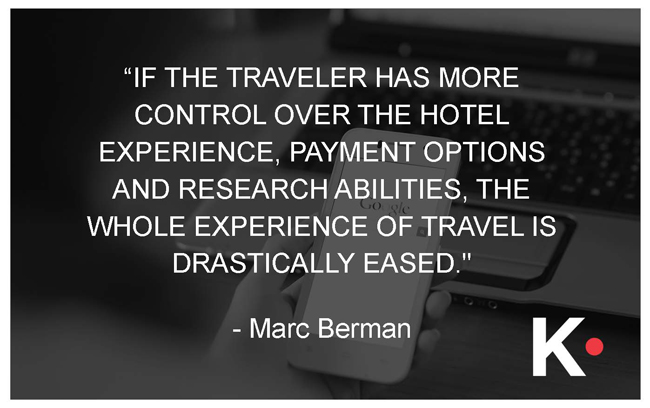
By Marc Berman
Does anyone remember what it was like to plan a trip before the days of the internet? Travel agencies were our best friends and we got around in new and foreign places by looking at maps–the paper kind.
Traveling today is an entirely different experience, most organized through a smartphone. I'm not sure how I'd get from point A to point B without mine. Loyalty programs, a key element of the travel experience for seasoned travelers, aren't left out of this need for digital elements. So why aren't these two elements put together more often?
To add more fuel to the fire, Millennials (today's largest and most tech-savvy generation) lead all users in terms of downloading hotel mobile apps at 64 percent, according to Deloitte. With the 80 million of them spending more than $600 billion annually, it's more important than ever that hotels bolster their digital loyalty offerings to keep in the race for the ever-coveted Millennial loyalty.
Large hospitality brands, including Hilton and Marriott, have recently launched new apps that have the right idea and ease several common pain points. Here are three lessons all hospitality brands must know about the travel experience–and how some brands are already addressing them with their loyalty programs.
- Planning is the journey before the adventure
Hospitality loyalty doesn't have to limit itself purely to the transaction step of the travel plan. A traveler's planning journey is much bigger than that. According to an Expedia Media Solutions survey, more that 60 percent of American digital users consume travel content. Collectively, they're spending 1.5 trillion minutes each month doing so. That makes for a lot of browsing, researching and planning.
Loyalty programs are beginning to catch onto this and are adding content into their offerings. Marriott's new loyalty app, launched in February, can deliver curated, original content from Marriott's digital magazine, Traveler, based on users' previous hotel searches or upcoming travels. This content helps the brand become present at other stages of the travel planning process, instead of just settling for the purchase touchpoint. Not to mention, it's sure to help the wanderlust kick in for those who are more likely to travel on a whim, or the business traveler plan a last-minute trip.
- Embrace the fact that travel is often a group activity
Solo travel may be on the rise, but traveling is still most often done in a group. In 2015, 76 percent of those who travelled did so in a group. Digital elements to the hotel-booking experience can ease the tension here, especially when it comes to payment.
The new Hilton Honors loyalty program allows users to pool their points with up to 10 friends or family members, giving it a leg up on Airbnb where users have to settle for only one payment method rather than splitting it across a group. The program also allows users to put a certain amount of points towards a stay rather than forcing them to pay for the stay entirely in one currency, a great feature for groups who don't have everyone participating in the program. Loyalty marketers sometimes neglect that group, though with easy payment options like this, brands can drive new membership.
Group versus solo travelling aside, this is some long-awaited flexibility in the world of hospitality loyalty. According to a Deloitte study on the state of hotel loyalty programs, proficient travelers ranked "more opportunities to redeem points" the top area for improvement in these programs.
- Travel is the definition of on-the-go, so loyalty needs to go mobile
When travelers aren't taking in their new surroundings, their noses are buried in their phones. From requesting a ride to the airport, scanning an airline ticket, keeping updated on the gate number, getting to the hotel and searching for a good local place to grab dinner once the journey is complete, the mobile experience is huge for me personally and to most travelers.
Loyalty programs are figuring this out, and amplifying apps to help travelers on the go. Marriott's new loyalty app includes enhanced mobile check-in, mobile room alerts and the option for loyalty members to request room upgrades and late check-outs in-app. This is a significant perk for those moments when you've had a rough flight, and all you want to do is head straight to your hotel room.
But the actual act of travelling isn't the only stage that needs mobile presence. According to Adobe, as of December 2015, most of the research and planning surrounding a trip is now done via mobile (phone and tablet) as opposed to on a desktop. Here's another point where Marriott is onto something by offering their digital Traveler content in the loyalty app.
Loyalty has always had a key role in the hospitality industry, but digital elements need to be present to maintain the hospitality industry's relevance. If the traveler has more control over the hotel experience, payment options and research abilities, the whole experience of travel is drastically eased. Marriott and Hilton's new loyalty efforts indicate we're moving in a promising direction.


